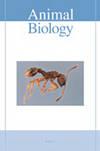羊毛结构脂与个体宏观结构成分、化学成分和物理指标的关系
IF 0.9
4区 生物学
Q2 ZOOLOGY
引用次数: 0
摘要
介绍了不同品种绵羊毛的结构组织、化学成分和物理参数的特点。研究发现,乌克兰喀尔巴阡山品种母羊的羽绒纤维中β-角化病含量最低(10.2%),α-角化症含量最高(64.4%),喀尔巴阡山母羊的保卫纤维中含量最高(15.1%)。然而,在这些母羊和Prekos品种母羊的羽绒纤维中,γ-角化病的含量最高,分别为28.4%和28.7%,总硫和胱氨酸的含量最高(2.9和2.9,11.2和11.5%)。此外,防护纤维中γ-角化病含量最低(58.2%),硫和胱氨酸含量最低(2.7%和9.0%)。已经证实,不同种类的纤维含有不同量的总脂质。游离脂质含量最低的是喀尔巴阡山母羊(0.75%)的瘦绒毛、普雷科斯母羊(0.71%)和阿斯坎羊(0.83%)的细羊毛,而数量最多的是喀尔巴阡山绵羊的半粗防护纤维(1.39%),建立了一个完全相反的差异:细绒毛中脂质含量最高(1.85%),半粗保护纤维中脂质含量最低(1.47%)。在保护纤维中,游离脂质含量最高的是非酯化胆固醇(绒毛中64.9%对56.5%,Ascanian母羊羊毛中57.7%,Prekos母羊63.3%),其中非酯化脂肪酸含量最低(9.6%),甾醇含量最低(9.2%)。但极性脂质的组成部分几乎由50%的神经酰胺和磺基脂质组成(超过20%)。同时,神经酰胺在结合脂质的部分中所占比例不超过40%。羊毛的物理指标在一定程度上反映了其结构和化学成分的特点。因此,防护纤维具有最高的强度(9.1 cN/tex)和细度(48.8μm),这是天然的,因为防护纤维具有最大含量的β-角化酶,即角质层和最高量的脂质。相反,最薄的纤维是羽绒纤维(16.9μm),它们是最弱的(7.0 cN/tex),并且这些纤维含有最少的β-角化酶。因此,游离脂质部分的含量与纤维直径之间存在直接关系(羽绒、细纤维和半粗纤维分别为r=0.996;0.887;0746),结合脂质的含量之间存在相反关系(r=-0.993;-0.995;-0.694)。本文章由计算机程序翻译,如有差异,请以英文原文为准。
The relationship between structural lipids of sheep wool with its individual macrostructural components, chemical composition and physical indicators
The data on the peculiarities of the structural organization, chemical composition and physical parameters of sheep wool of different breeds depending on the type of their hair are presented. It has been found that the down fibers of ewes of the Ukrainian Carpathian Mountain breed possess the lowest content of β-keratosis (10.2%) and the highest content of α-keratosis (64.4%). In the fine wool of Ascanian ewes and Prekos ewes, the content of β-keratosis is 12.9 and 11.5%, respectively, and the highest content of it (15.1%) is contained in the guard fibers of the Carpathian Mountain ewes. However, in the down fibers of these ewes and the Prekos breed ewes, there is the highest content of γ-keratosis ― 28.4 and 28.7%, the total sulfur and cystine (2.9 and 2.9 and 11.2 and 11.5%), respectively. Besides that, the guard fibers contain the lowest content of both γ-keratosis (58.2%) and sulfur and cystine (2.7 and 9.0%), respectively. It has been established that different categories of fibers contain different amounts of total lipids. The smallest amounts of free lipids are found in the thin down of the Carpathian Mountain ewes (0.75%), the thin wool of the Prekos ewes (0.71%) and Ascanian ewes (0.83%), and the largest number of them is found in the semi-coarse guard fibers of the Carpathian Mountain sheep (1.39%). For bound lipids, a diametrically opposite difference was established: the largest amount of lipids was found in the thin down (1.85%), and the smallest amount — in the semi-coarse guard fibers (1.47%). In the guard fibers, the biggest amount of free lipids is accounted for the fraction of non-esterified cholesterol (64.9% versus 56.5% in the down, 57.7 in the wool of Ascanian ewes and 63.3% in the Prekos ewes), and the least of all they contain the fraction of non-esterified fatty acids (9.6%), and another sterol fraction (9.2%). The fibers of the Prekos breed sheep are noted with the lowest content of esterified cholesterol (8.9%) and the highest content of non-esterified fatty acids. But the fraction of polar lipids consists of almost 50% of ceramides and sulfolipids (more than 20%). At the same time, ceramides account for no more than 40% in the fraction of bound lipids. Physical indicators of wool to some extent reflect the peculiarities of its structure and chemical composition. Thus, the guard fibers have the highest strength (9.1 cN/tex) and fineness (48.8 μm), which is natural, because the guard has the highest content of β-keratose, i.e. cuticle, and the highest amount of lipids. Instead, the thinnest fibers are down fibers (16.9 μm) and they are the weakest (7.0 cN/tex) and these fibers contain the least β-keratose. Thus, there is a direct relationship between the content of the free lipid fraction and the fiber diameter (r = 0.996; 0.887; 0746 for down, fine and semi-coarse, respectively), and between the content of bound lipids — inverse (r = –0.993;–0.995; –0.694).
求助全文
通过发布文献求助,成功后即可免费获取论文全文。
去求助
来源期刊

Animal Biology
生物-动物学
CiteScore
2.10
自引率
0.00%
发文量
34
审稿时长
3 months
期刊介绍:
Animal Biology publishes high quality papers and focuses on integration of the various disciplines within the broad field of zoology. These disciplines include behaviour, developmental biology, ecology, endocrinology, evolutionary biology, genomics, morphology, neurobiology, physiology, systematics and theoretical biology. Purely descriptive papers will not be considered for publication.
Animal Biology is the official journal of the Royal Dutch Zoological Society since its foundation in 1872. The journal was initially called Archives Néerlandaises de Zoologie, which was changed in 1952 to Netherlands Journal of Zoology, the current name was established in 2003.
 求助内容:
求助内容: 应助结果提醒方式:
应助结果提醒方式:


